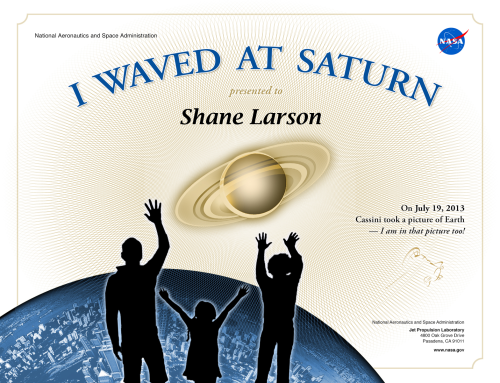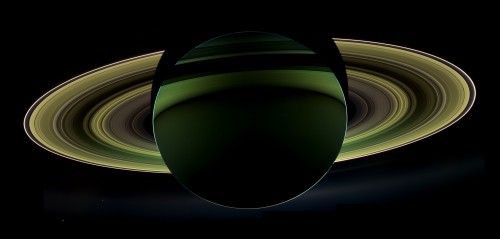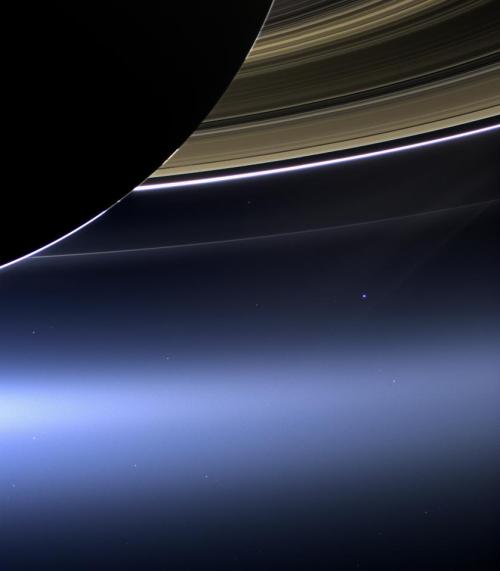by Shane L. Larson
I am writing this on the 45th anniversary of one of the most iconic photographs of the Space Age. As Bill Anders, Frank Borman and Jim Lovell rounded the far side of the Moon, after traveling farther than any humans in history, they beheld a sight that had never been seen before — the distant blue sphere of the Earth rising over the horizon of the Moon. This single image captured an idea which up to that time was a mere abstraction — that the Earth is a single world, without borders and boundaries, interconnected and bound together in ways that are simultaneously obvious and subtle.

(L) The original Earthrise image, shot by Bill Anders on Apollo 8’s 4th lunar orbit in 1968. (R) Recreated Earthrise image by NASA’s Lunar Reconnaissance Orbiter.
This is the nature of great voyages of exploration and discovery — finding the unexpected, and realizing it was the most important thing that happened. The Earthrise image, like image of Buzz Aldrin’s bootprint on the Moon, or the Genesis rock found by Apollo 15 Commander Dave Scott on the delta of Hadley Rille — those are transformative moments from the Age of Space Exploration that changed how we think about who we are.
![(L) The Apollo 15 Genesis Rock, in situ as found on the Moon at Hadley Rille, and in the Lunar Sample Laboratory at Johnson Space Center. (R) Aldrin's bootprint experiment on the surface of the Moon [Apollo image AS11_40_5880], and the iconic image that symbolizes humanity's first voyage beyond the Earth [Apollo image AS11_40_5878].](https://writescience.files.wordpress.com/2013/12/moonimages.jpg?w=500&h=124)
(L) The Apollo 15 Genesis Rock, in situ as found on the Moon at Hadley Rille, and in the Lunar Sample Laboratory at Johnson Space Center. (R) Aldrin’s bootprint experiment on the surface of the Moon [Apollo image AS11_40_5880], and the iconic image that symbolizes humanity’s first voyage beyond the Earth [Apollo image AS11_40_5878].
Human beings are good at figuring things out. Sometimes we do it for recreation — we play tangrams, we play matchstick riddles, we solve Soduku puzzles. Sometimes we do it because we have to, because our very survival depends on it — we figure how to shore up the banks of a river before it floods a town, we figure how to rescue a family who’s car has skidded off an icy road into a ravine, or we figure how to increase grain yields to feed a million starving people. Sometimes we do it to improve our lives — we know how to make the human body invincible against the polio virus, we know how to forecast the arrival of a hurricane along our seaboards, and we know how to make the sum total of all the knowledge of the human race available to anyone on a device that fits in your pocket.
 Science is a way of thinking about the world specifically geared toward figuring out how things are related. That everything on Earth is deeply interconnected is one of the great realizations of the last two hundred years. Consider the Wave Rock in the Hyden Wildlife Park of Western Australia: 14 meters high, and 110 meters long, Wave Rock has the shape of an enormous cresting wave on the ocean, but the nearest seashore is 300 km away. That Wave Rock is a natural formation is clear. But how did it get there? How did it form? This formation is an example of weathering and erosion. Constant and continued exposure to weather, wind and rain have eroded the rockface away, leaving the flared shape of a cresting wave. It happened slowly, over millions of years, far too slowly for humans to observe, but we figured it out.
Science is a way of thinking about the world specifically geared toward figuring out how things are related. That everything on Earth is deeply interconnected is one of the great realizations of the last two hundred years. Consider the Wave Rock in the Hyden Wildlife Park of Western Australia: 14 meters high, and 110 meters long, Wave Rock has the shape of an enormous cresting wave on the ocean, but the nearest seashore is 300 km away. That Wave Rock is a natural formation is clear. But how did it get there? How did it form? This formation is an example of weathering and erosion. Constant and continued exposure to weather, wind and rain have eroded the rockface away, leaving the flared shape of a cresting wave. It happened slowly, over millions of years, far too slowly for humans to observe, but we figured it out.
![Examples of weathering processes on Earth. (L) The Grand Canyon of the Yellowstone. (C) Rub' al Khali, the "Empty Quarter" on the Arabian Penninsula. (R) The Elephant's Foot Glacier, in Greenland. [Images from Wikimedia Commons.]](https://writescience.files.wordpress.com/2013/12/weathering.jpg?w=500&h=207)
Examples of weathering processes on Earth. (L) The Grand Canyon of the Yellowstone. (C) Rub’ al Khali, the “Empty Quarter” on the Arabian Penninsula. (R) The Elephant’s Foot Glacier, in Greenland. [Images from Wikimedia Commons.]
![Water in all three forms found on Earth: liquid, ice, and vapor (clouds). [Image from Wikimedia Commons.]](https://writescience.files.wordpress.com/2013/12/iceberg_with_hole_near_sanderson_hope_2007-07-28_2.jpg?w=500&h=287)
Water in all three forms found on Earth: liquid, ice, and vapor (clouds). [Image from Wikimedia Commons.]
![A hot Jupiter near its parent star. [Image from NASA.]](https://writescience.files.wordpress.com/2013/12/heic0612b.jpg?w=300&h=225)
A hot Jupiter near its parent star. [Image from NASA.]
![(L) Saturn's moon Titan, seen up close by the Cassini spacecraft in ultraviolet light. (R) Titan's liquid hydrocarbon lakes, displayed in false color (colored by computer). [Images from Wikimedia Commons.]](https://writescience.files.wordpress.com/2013/12/titanlakes.jpg?w=500&h=284)
(L) Saturn’s moon Titan, seen up close by the Cassini spacecraft in ultraviolet light. (R) Titan’s liquid hydrocarbon lakes, displayed in false color (colored by computer). [Images from Wikimedia Commons.]

What might lie beneath the icy surface of Europa? Future missions may tell us. [Illustration by S. Larson]
The knowledge that Venus is a hothouse without equal has passed into the collective knowledge of our civilization, a bit of information that most people know and can use to win a Saturday night game of Trivial Pursuit. But we have not always known this fact; it was something we figured out. That Venus was shrouded in an apparently eternal cloud layer was a fact known since the invention of the telescope. Having little experience with clouds other than those on Earth, it was oft assumed that the clouds were water-based, and that Venus was a watery, swampy morass — perhaps not a heavenly paradise, but certainly no less-liveable than the jungles of the Congo or the back-bayous of southern North America.

Approximately true color image from the surface of Venus, taken by the Soviet Venera 14 lander in 1981.
But science is a self-correcting process. When new information is discovered, we revisit old thoughts, old models, old assumptions and view them anew, asking ourselves “how have we fooled ourselves this time?” We generate new ideas that explain all of the old information and the new information together. Such is the case with Venus. In the 1950’s, the advent of electronic technology allowed us, for the first time, to detect microwaves being emitted from our nearby sister world. This was a startling revelation — how could it be that a planet was emitting copious amounts of microwaves? The puzzle was resolved by a young Carl Sagan in 1960, who in his Ph.D. thesis demonstrated the basic runaway-greenhouse effect model that successfully explains the character of Venus. The clue to the existence of the greenhouse effect was the microwaves — hot gasses produce copious amounts of microwaves. This was confirmed directly by the Soviet Venera 9 spacecraft, which soft-landed on Venus on 20 October 1975. It was the first human spacecraft to return pictures from the surface of another planet; it survived for 53 minutes. Today, Venera 9 is slowly eroding away under the oppressive heat, pressure, and acidic rain, a decaying testament to the human penchant for figuring things out.
![The Venera landers lived very short lives on the hellish landscape of Venus. Long ago fallen silent, they are now slowly eroding away. [Illustration by S. Larson]](https://writescience.files.wordpress.com/2013/12/veneramoleskine.jpg?w=500&h=318)
The Venera landers lived very short lives on the hellish landscape of Venus. Long ago fallen silent, they are now slowly eroding away. [Illustration by S. Larson]
————————————
This post is part of an ongoing series, celebrating the forthcoming science series, Cosmos: A Spacetime Odyssey by revisiting the themes of Carl Sagan’s classic series, Cosmos: A Personal Voyage. The introductory post of the series, with links to all other posts may be found here: http://wp.me/p19G0g-dE
















